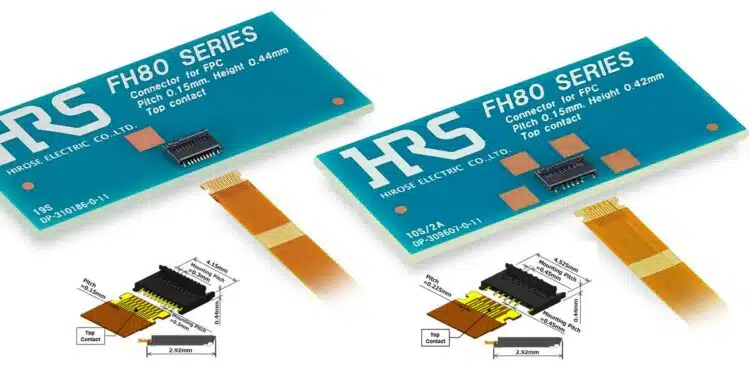Hirose Electric Co., Ltd. has introduced the FH80 backflip FPC board to board connector, featuring the industry’s lowest profile height of just 0.44mm and an ultra-narrow 0.15mm pitch.
Engineered to meet the demands of increasingly compact wearable devices such as smartwatches, the FH80 enables thinner designs without sacrificing performance—solving key design challenges in the rapidly growing wearables market.
In addition, a version equipped with power contacts supporting up to 2A is available, helping meet the demand for higher-capacity batteries and power-hungry functions in next-generation devices.
Current Status and Challenges in Wearable Device Design
The demand for smartwatches and other wearable devices has grown rapidly in recent years. In fact, the smartwatch market is expected to grow about 1.5 times in 2026 compared to 2022.
As the wearable market expands, manufacturers face increasing pressure to make products thinner, integrate larger batteries, and support more advanced functionality. However, conventional connectors often present limitations—such as height restrictions, limited mounting space, and insufficient power handling—making it difficult to achieve the design flexibility and performance required for next-generation devices.
Supports Slimmer, More Functional Device Layouts
Hirose Electric Co., Ltd. announced the new Item FH80. This FPC connector has an ultra-low height ultra-narrow pitch design that is ideal for wearable devices such as smartwatches and contributes to the thinning of devices. The FPC connector is also available with power contacts and is suitable for connecting wearable devices to batteries.
Features
- Ultra-Low Height Design: only 0.44mm high. Enables greater design flexibility without compromising connector height—supporting the development of more functional, compact wearables.
- Ultra-Narrow Pitch: pitch 0.15mm. Supports high-density layouts by preserving module mounting space as devices become increasingly multifunctional.
- High Current Capability: Power Contact Supports 2A. Ideal for connecting batteries in wearable and compact IoT devices where higher battery capacity is required.
- Back Flip Structure with Resistance to Vertical Stress. Designed with a retention tab to prevent actuator disengagement—ensuring high reliability even under upward or downward pulling forces, while maintaining an ultra-low profile.































